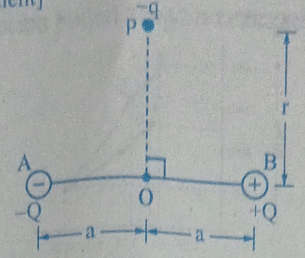In the situation shown in the diagram, magnitude of q << | Q | and r>>a. The net force on the free charge -q and net torque on it about O at the instant shown are respectively
[ p = 2aQ is the dipole moment ]

[ p = 2aQ is the dipole moment ]

- \(\frac{1}{4\pi\epsilon_0}\frac{pq}{r^2}\hat{k},\frac{1}{4\pi\epsilon_0}\frac{pq}{r^3}\hat{i}\)
- \(-\frac{1}{4\pi\epsilon_0}\frac{pq}{r^2}\hat{k},-\frac{1}{4\pi\epsilon_0}\frac{pq}{r^3}\hat{i}\)
- \(\frac{1}{4\pi\epsilon_0}\frac{pq}{r^3}\hat{i},+\frac{1}{4\pi\epsilon_0}\frac{pq}{r^2}\hat{k}\)
- \(\frac{1}{4\pi\epsilon_0}\frac{pq}{r^3}\hat{i},-\frac{1}{4\pi\epsilon_0}\frac{pq}{r^2}\hat{k}\)
The Correct Option is D
Approach Solution - 1
Given:
- Charge \( q \) is much smaller than \( |Q| \).
- Distance \( r \gg a \).
- Dipole moment \( p = 2aQ \).
Step 1: Finding the Net Force on Charge \(-q\)
The force on a charge due to a dipole at a large distance \( r \) is given by:
\[ \mathbf{F} = \frac{1}{4\pi\epsilon_0} \frac{pq}{r^3} \hat{i} \]
Step 2: Finding the Net Torque about Point O
The torque on the charge \(-q\) due to the dipole is:
\[ \mathbf{\tau} = -\frac{1}{4\pi\epsilon_0} \frac{pq}{r^2} \hat{k} \]
Answer: The correct option is D.
Approach Solution -2
We are given a situation where a dipole moment \( p = 2aQ \) is formed by two charges, \( +Q \) and \( -Q \), separated by a distance \( 2a \). A third charge \( -q \) is at a distance \( r \) from the dipole, where \( r \gg a \). We are tasked with finding the net force on the charge \( -q \) and the net torque on it about the origin \( O \).
Step 1: Net Force on the Charge \( -q \) The force on a charge \( -q \) due to a dipole is given by the equation: \[ \vec{F} = \frac{1}{4 \pi \epsilon_0} \frac{1}{r^3} \left( 3 \hat{r} (\hat{p} \cdot \hat{r}) - \hat{p} \right) q \] Since \( p = 2aQ \), we substitute \( p \) and calculate the net force acting on the charge. The force on \( -q \) is in the direction of \( \hat{r} \), and the magnitude is proportional to \( \frac{pq}{r^3} \). The direction of this force is along \( \hat{r} \). Thus, the net force on the charge \( -q \) is: \[ \vec{F} = \frac{1}{4 \pi \epsilon_0} \frac{pq \hat{r}}{r^3} \]
Step 2: Net Torque on the Charge \( -q \) The torque \( \vec{\tau} \) on a charge \( q \) placed in the electric field due to a dipole is given by: \[ \vec{\tau} = \vec{r} \times \vec{F} \] The torque is perpendicular to both the position vector \( \vec{r} \) and the force vector \( \vec{F} \). Therefore, the torque on the charge is along \( \hat{k} \), which is perpendicular to the plane formed by \( \hat{r} \) and \( \vec{F} \), and is proportional to \( \frac{pq}{r^2} \). Thus, the net torque on the charge \( -q \) is: \[ \vec{\tau} = \frac{1}{4 \pi \epsilon_0} \frac{pq \hat{k}}{r^2} \]
Conclusion: The net force on the charge \( -q \) is \( \frac{1}{4 \pi \epsilon_0} \frac{pq \hat{r}}{r^3} \), and the net torque is \( \frac{1}{4 \pi \epsilon_0} \frac{pq \hat{k}}{r^2} \).
Thus, the correct answer is option (D).
Top Questions on Electric Dipole
- An electric dipole of dipole moment \(6 \times 10^{-6} \) Cm is placed in a uniform electric field of magnitude \(10^6\) V/m. Initially, the dipole moment is parallel to the electric field. The work that needs to be done on the dipole to make its dipole moment opposite to the field will be ________________________ J.
- JEE Main - 2025
- Physics
- Electric Dipole
- An electric dipole of mass \( m \), charge \( q \), and length \( l \) is placed in a uniform electric field \( E = E_0 \hat{i} \). When the dipole is rotated slightly from its equilibrium position and released, the time period of its oscillations will be:
- JEE Main - 2025
- Physics
- Electric Dipole
- An electric dipole with dipole moment \(p = 5 \times 10^{-6}\) Cm is aligned with the direction of a uniform electric field of magnitude \(E = 4 \times 10^5\) N/C. The dipole is then rotated through an angle of \(60^\circ\) with respect to the electric field. The change in the potential energy of the dipole is:
- NEET (UG) - 2025
- Physics
- Electric Dipole
- The distance between two equal and opposite charges of \( 0.2 \mu C \) will be 3.0 cm. Their electric dipole moment will be
- Bihar Board XII - 2025
- Physics
- Electric Dipole
- Inside a closed surface, n electric dipoles are situated. The electric flux coming out from the closed surface will be
- Bihar Board XII - 2025
- Physics
- Electric Dipole
Questions Asked in KCET exam
- A body of mass 0.25 kg travels along a straight line from \( x = 0 \) to \( x = 2 \, \text{m} \) with a speed \( v = k x^2 \) where \( k = 2 \, \text{m}^{-1} \). The work done by the net force during this displacement is
- KCET - 2025
- Elastic and inelastic collisions
- The minimum value of \( 1 - \sin x \) is:
- KCET - 2025
- Inverse Trigonometric Functions
Match List-I with List-II and select the correct option:

- KCET - 2025
- Bond Parameters
- The maximum value of \( z = 3x + 4y \), subject to the constraints \( x + y \leq 40, x + 2y \geq 60 \) and \( x, y \geq 0 \) is:
- KCET - 2025
- Linear Programming Problem
- Given, a current carrying wire of non-uniform cross-section, which of the following is constant throughout the length of the wire?
- KCET - 2025
- Current electricity